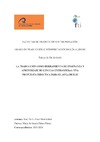Please use this identifier to cite or link to this item:
https://accedacris.ulpgc.es/jspui/handle/10553/73756
| DC Field | Value | Language |
|---|---|---|
| dc.contributor.advisor | Piñero Piñero, María De Gracia | es |
| dc.contributor.author | De La Nuez Mendizábal, Raúl | es |
| dc.date.accessioned | 2020-07-22T11:32:10Z | - |
| dc.date.available | 2020-07-22T11:32:10Z | - |
| dc.date.issued | 2020 | - |
| dc.identifier.uri | https://accedacris.ulpgc.es/handle/10553/73756 | - |
| dc.description.abstract | Existen abundantes herramientas, metodologías y recursos en el campo de la enseñanza y aprendizaje de lenguas extranjeras. Durante los últimos años se han desarrollado multitud de métodos y teorías que han revolucionado la forma en la que aprendemos, adquirimos y desarrollamos conocimientos en otras lenguas. Entre ellos, la traducción ha estado siempre presente en este campo, de una u otra forma, y en las últimas décadas ha vuelto a emerger como herramienta de apoyo pedagógico. Como consecuencia, han surgido nuevos enfoques de la denominada traducción pedagógica, que suponen un soporte eficaz para profesores y alumnos en el aula de segundas lenguas. Este trabajo estudia el papel que ha tenido y que puede llegar a alcanzar la traducción como pilar didáctico en la enseñanza y aprendizaje de lenguas extranjeras. Para ello, se abordan las utilidades, los beneficios y los inconvenientes que la traducción pedagógica plantea en el aula. Asimismo, se presenta, como muestra de la rentabilidad de la traducción pedagógica en este contexto, una propuesta didáctica destinada a los aprendientes de ELE de nivel A1 y A2, cuyos materiales lingüísticos se han desarrollado teniendo en cuenta los niveles de referencia propuestos por el Marco Común Europeo de Referencia para las lenguas (MCER) y por el Plan curricular del Instituto Cervantes. | en_US |
| dc.description.abstract | There are numerous tools, methodologies and resources in the area of foreign language teaching and learning. In the last years, multiple methods and theories that have revolutionized the way we learn, teach and acquire foreign languages have been developed. Translation, among them, has somehow always been present in this field and, in the last decades, it has re-emerged as a didactic support tool. As a result, new methods and teaching approaches to so-called pedagogical translation have been developed, providing support for teachers and students in the second language classroom. This work studies the role that translation has had and could have as didactic aid in the field of foreign language teaching and learning. To this end, utilities, benefits and deficiencies that pedagogical translation may have in the classroom are addressed. Likewise, as an example of the efficiency of pedagogical translation in the field of foreign language teaching and learning, a didactic proposal is presented. This teaching proposal is aimed at A1 and A2 level learners of Spanish as a foreign language, and the linguistic materials have been developed taking into account the reference levels proposed by the Common European Framework of Reference for Languages (CEFR) and the Cervantes Institute Curriculum Plan. | en_US |
| dc.language | spa | en_US |
| dc.subject | 570113 Lingüística aplicada a la traducción e interpretación | en_US |
| dc.subject.other | Traducción pedagógica | es |
| dc.subject.other | Didáctica de lenguas extranjeras | es |
| dc.subject.other | Enseñanza y aprendizaje de ELE | es |
| dc.subject.other | Metodología didáctica | es |
| dc.subject.other | Propuesta didáctica | es |
| dc.subject.other | Pedagogical translation | es |
| dc.subject.other | Foreign language teaching | es |
| dc.subject.other | SSL teaching and learning | es |
| dc.subject.other | Didactic methodology | es |
| dc.subject.other | Didactic proposal | es |
| dc.title | La traducción como herramienta de enseñanza y aprendizaje de lenguas extranjeras: una propuesta didáctica para el aula de ELE | es |
| dc.type | info:eu-repo/semantics/bachelorThesis | en_US |
| dc.type | BachelorThesis | en_US |
| dc.contributor.departamento | Departamento de Filología Hispánica Clásica Y De Estudios Árabes Y Orientales | es |
| dc.contributor.facultad | Facultad de Traducción e Interpretación | en_US |
| dc.investigacion | Artes y Humanidades | en_US |
| dc.type2 | Trabajo final de grado | en_US |
| dc.description.notas | Grado en traducción e interpretación Inglés-Alemán | en_US |
| dc.utils.revision | Sí | en_US |
| dc.identifier.matricula | TFT-59919 | es |
| dc.identifier.ulpgc | Sí | es |
| dc.contributor.titulacion | Grado en Traducción e Interpretación: Inglés-Alemán | es |
| item.grantfulltext | open | - |
| item.fulltext | Con texto completo | - |
| crisitem.advisor.dept | GIR IATEXT: Cognición, Lingüística, Texto y Procesamiento de la Información | - |
| crisitem.advisor.dept | IU de Análisis y Aplicaciones Textuales | - |
| crisitem.advisor.dept | Departamento de Filología Hispánica, Clásica y de Estudios Árabes y Orientales | - |
| Appears in Collections: | Trabajo final de grado | |
Page view(s)
364
checked on Nov 16, 2024
Download(s)
2,139
checked on Nov 16, 2024
Google ScholarTM
Check
Share
Export metadata
Items in accedaCRIS are protected by copyright, with all rights reserved, unless otherwise indicated.
